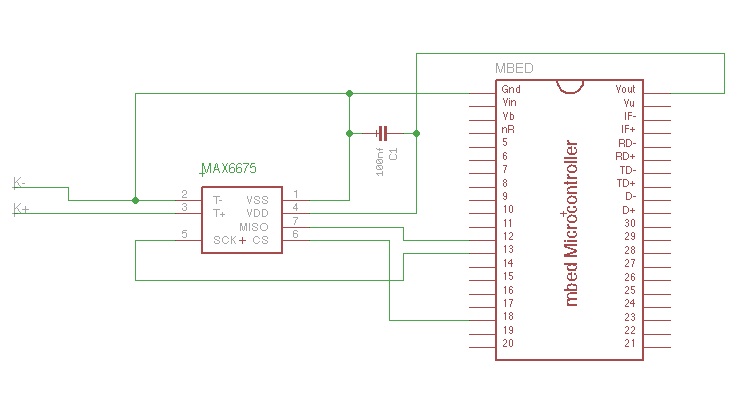MAX6675 Thermocouple
Note
This page has been moved to the Components section of the website. Please see http://developer.mbed.org/components/MAX6675-Thermocouple/ .
I have an big interest in car tuning and modifications, and exhaust temperature is a good way to gauge engine problems. In general the colder the exhaust gasses are, the richer the fuel mixture, the warmer the exhaust gasses are the leaner the fuel mixture. I don't recommend using this for tuning an engine, a wideband lambda is much more appropriate. And your engine should only be used by a engine tuning specialist. But if your like me, you might want build something like this for race purposes. Or on another note, it could be great way to monitor a home built reflow oven.
Schematic¶

Reading The Temperature¶
#include "mbed.h"
#include "max6675.h"
SPI spi(p11,p12,p13);
max6675 max(spi,p18);
Serial pc(USBTX,USBRX);
int main() {
while (1) {
float temp = max.read_temp();
printf("\n\rT: %f",temp );
wait(.25);
}
}
K Type Thermocouple¶

A bit about the K Type thermocouple (Extract from Wikipedia, link below)
Type K (chromel–alumel) is the most common general purpose thermocouple with a sensitivity of approximately 41 µV/°C, chromel positive relative to alumel.[6] It is inexpensive, and a wide variety of probes are available in its −200 °C to +1350 °C / -328 °F to +2462 °F range. Type K was specified at a time when metallurgy was less advanced than it is today, and consequently characteristics vary considerably between samples. One of the constituent metals, nickel, is magnetic; a characteristic of thermocouples made with magnetic material is that they undergo a step change in output when the magnetic material reaches its Curie point (around 354 °C for type K thermocouples).